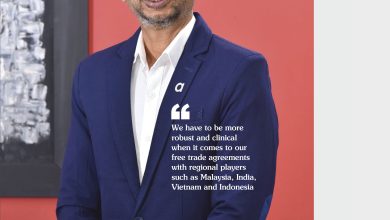CUTTING-EDGE SUSTAINABILITY

Group Chief Executive Officer
Brandix
The apparel industry finds itself in a unique position vis-à-vis a window of opportunity in the world export market. In the eyes of Ashroff Omar, the country’s current standing is bolstered by several external factors including challenges faced by competitors such as Bangladesh.
“While Bangladesh continues to function reasonably well, concerns over potential supply chain disruptions have made customers cautious. Many have taken proactive steps to mitigate their exposure to Bangladesh with some even exploring options in Sri Lanka,” Omar explains.
Additionally, the tariffs instigated trade war between the US and China has positioned Sri Lanka as a more attractive destination for buyers.
He maintains that this environment presents a unique opportunity for growth, even if it is modest.
“Despite being relatively small in the global apparel market, Sri Lanka has immense potential to expand under these circumstances. We are seeing interest not only from international buyers but also companies in Bangladesh and India, which are considering setting up factories here,” he reveals.
Despite these opportunities, Sri Lanka’s apparel industry faces significant challenges, particularly in the aftermath of the economic crisis. One key issue is the impact of currency fluctuations. “The currency depreciation initially benefited exporters but it also led to a sharp rise in costs – including salaries and other expenses,” Omar notes.
Another critical challenge lies in increasing local fabric production. Currently, Sri Lanka relies heavily on imported fabrics with local mills meeting only 30-40 percent of total requirements.
“Growing global demand, coupled with our strengths in sustainability and quality, provide us with an excellent opportunity to thrive”

He emphasises: “More investment is needed to boost domestic fabric production. If we can reduce the reliance on imports and respond faster, it will significantly improve our competitiveness.”
Omar also highlights the importance of investing in high poverty regions to establish industrial zones: “According to Sri Lanka’s poverty map, these areas can greatly benefit from such zones. This initiative should ideally be led by the government with private sector involvement.”
Stability in the broader economy, supported by the ongoing IMF programme, is also crucial. Omar observes that “the programme has brought greater economic stability and limits risky decision making. And if this stability continues, I believe most other challenges can be mitigated.”
Sustainability remains a cornerstone of the apparel industry and a critical factor in its export strategy; and as Omar notes, “Sri Lanka has long been a leader in sustainability and this remains a key priority.”
While global enthusiasm for sustainability may fluctuate due to political shifts, the demand for sustainable practices continues to grow.
However, Omar believes that sustainability must be approached pragmatically. “True sustainability aligns with business principles – i.e. producing more with less energy, minimising waste and maximising efficiency. It’s not simply about ticking boxes or adopting overly activist measures that hinder operations,” he cautions.
Though sustainable practices may require higher initial investments, there are international funding opportunities available to support such efforts. Addressing issues such as waste and pollution is essential for meeting customer demands, and contributing to a cleaner and more responsible industry.
Despite these hurdles, Omar remains optimistic about Sri Lanka’s future in the apparel export market: “Sri Lanka is in a sweet spot at the moment. Growing global demand coupled with our strengths in sustainability and quality provide us with an excellent opportunity to thrive.”




